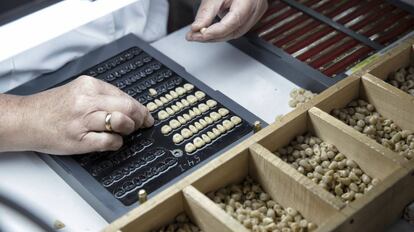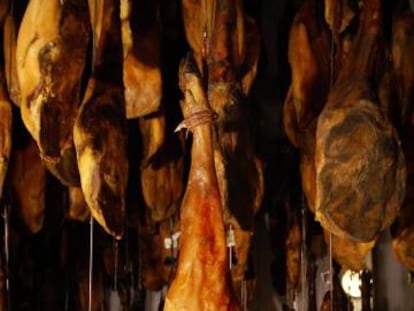A business with bite: Spain’s false teeth success story
A family firm located on the outskirts of Madrid produces 12 million dentures a year for 52 countries
Whether it’s a Vietnamese grandmother or a Peruvian fisherman, if they’re wearing false teeth, the chances are they came from the same Spanish factory. And behind that factory is a love story dating back more than half a century.

Back in the 1950s, an 18-year-old girl from the northern town of León saw a classified advertisement for a secretary, applied for the position, and got it. Her boss then fell in love with her, but her father wouldn’t let them get married, so she moved back to her hometown. Her love followed her, and after marrying, they decided to start their own business. And that business turned out to be Spain’s only false teeth factory.
Sixty-four years later and Unidesa-Odi is still Spain’s only denture manufacturer. Based in the Madrid town of Tielmes, it exports to 52 countries. Today, the grandchildren of the star-crossed lovers, Ana María Álvarez and José Domínguez, also work in the business.
When Ana María and her husband started out in the denture industry, false teeth were still made by hand
“When we opened the factory all of the homes in the town put out bunting to celebrate, it was amazing! Before, young women had to move to Madrid to work as housemaids, but once we set up shop… none of the girls ever left again. Actually, a lot of them who started when they were 14 or 15 years old are still here, and now they’re grandmothers,” says Ana María, now aged 87, wiping away a tear. It was the first time in three years she’s been to the factory she created.
“Her girls”, who are now in their seventies, greet her affectionately and some of them call her “grandma.”
She says her husband and business partner, José Domínguez, “who was always working, like a good Galician,” chose Tielmes because it wasn’t so big that other industries would come and it wasn’t so small that they would have trouble finding people to work there, says Ana María. The town, located about 50 kilometers to the southeast of Madrid, has a population of around 2,600.
“All the girls from the town came here. They started really young, then they got married and left,” says José Luis Sanz, head of the pigmentation department.
I’m amazed at how much things have changed… madre mía! Ana María Álvarez, Unidesa-Odi founder
However, not all the women left, Inmaculada Redondo and María Cecilia Redondo, have been working at the factory for 43 years. “It’s great to work with the same people,” they say.
When Ana María and her husband started out in the denture industry, false teeth were still made by hand. Today, a machine she calls the "robot" produces more than 60 a minute.
“I’m amazed whenever I see the robot, and at how much things have changed… madre mía. In the beginning we just mixed a little powder with some liquid in a small cup.”
The company makes a total of 12 million dentures every year.
“Demand depends on the morphology of our clients. African countries ask for whiter teeth that are more of a square shape, while people in Asia like smaller teeth, made of ivory,” Soraya Domínguez, the export manager, explains.
“We have a variety of colors, from very bright to darker. We realized that people from the United States like their teeth really, really white and so we had to create a brighter white for them,” says Soraya’s nephew, Guillermo Domínguez, who heads the development and research department.
The plant is more like a laboratory than a factory. Bottles labeled with the names of chemicals line shelves in the different sections. Other shelves are lined with powders that range from dark brown to phosphorescent fuchsia. Those colors are used to give the teeth their distinct tones. The molds for the teeth look like car clutches and before they put the product in one of the hundreds of boxes for final processing, machines beat and stir the mix as if they were white chocolate bonbons.
Ana María developed much her dental empire alone after her husband died nearly half a century ago. Still vibrant and full of energy, she swims more than half a kilometer in 40 minutes, four times a week.
She quit working nearly 15 years ago when the company was restructured and half of the workers were fired, leaving just 60 workers and the “robot” that produces the teeth. “I couldn’t stay,” she says.
English version: Alyssa McMurtry.
Tu suscripción se está usando en otro dispositivo
¿Quieres añadir otro usuario a tu suscripción?
Si continúas leyendo en este dispositivo, no se podrá leer en el otro.
FlechaTu suscripción se está usando en otro dispositivo y solo puedes acceder a EL PAÍS desde un dispositivo a la vez.
Si quieres compartir tu cuenta, cambia tu suscripción a la modalidad Premium, así podrás añadir otro usuario. Cada uno accederá con su propia cuenta de email, lo que os permitirá personalizar vuestra experiencia en EL PAÍS.
¿Tienes una suscripción de empresa? Accede aquí para contratar más cuentas.
En el caso de no saber quién está usando tu cuenta, te recomendamos cambiar tu contraseña aquí.
Si decides continuar compartiendo tu cuenta, este mensaje se mostrará en tu dispositivo y en el de la otra persona que está usando tu cuenta de forma indefinida, afectando a tu experiencia de lectura. Puedes consultar aquí los términos y condiciones de la suscripción digital.
More information
Archived In
Últimas noticias
Maduro pleads not guilty before the federal court in New York: ‘I am still the president of Venezuela’
A new test can detect Alzheimer’s from a finger prick
UN team enters Sudanese city of El Fasher after paramilitary massacre: ‘It’s like a ghost town’
A recipe for resistance: Indigenous peoples politicize their struggles from the kitchen
Most viewed
- Gilles Lipovetsky: ‘If you want to live better and fall in love, take Prozac, don’t look to philosophy’
- Alain Aspect, Nobel laureate in physics: ‘Einstein was so smart that he would have had to recognize quantum entanglement’
- Maduro’s downfall puts China’s relationship with Venezuela to the test
- Why oil has been at the center of Venezuela-US conflicts for decades
- Alvin Hellerstein, a 92-year-old judge appointed by Bill Clinton, to preside over Maduro’s trial in New York











































